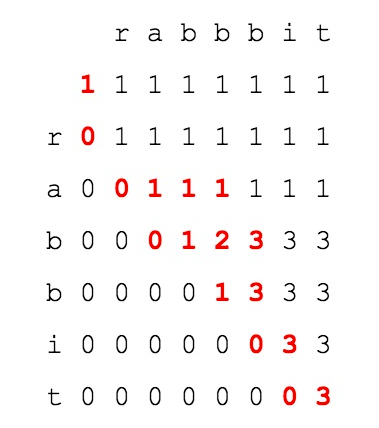Given a string S and a string T, count the number of distinct subsequences of S which equals T.
A subsequence of a string is a new string which is formed from the original string by deleting some (can be none) of the characters without disturbing the relative positions of the remaining characters. (ie, "ACE" is a subsequence of "ABCDE" while "AEC" is not).
Example 1:
Input: S ="rabbbit", T ="rabbit" Output: 3Explanation: As shown below, there are 3 ways you can generate "rabbit" from S. (The caret symbol ^ means the chosen letters)rabbbit^^^^ ^^rabbbit^^ ^^^^rabbbit^^^ ^^^
Example 2:
Input: S ="babgbag", T ="bag" Output: 5Explanation: As shown below, there are 5 ways you can generate "bag" from S. (The caret symbol ^ means the chosen letters)babgbag^^ ^babgbag^^ ^babgbag^ ^^babgbag^ ^^babgbag^^^
class Solution { public int numDistinct(String s, String t) { int m = t.length(); int n = s.length(); int[][] dp = new int[m + 1][n + 1]; for(int j = 0; j <= n; j++){ dp[0][j] = 1; } for(int i = 1; i <= m; i++){ for(int j = 1; j <= n; j++){ dp[i][j] = dp[i][j - 1] + (t.charAt(i-1) == s.charAt(j-1) ? dp[i - 1][j - 1] : 0); } } return dp[m][n]; } }
分析如下:
动态规划题目。
以S ="rabbbit",T = "rabbit"为例):


dp[i][j]表示T的从0开始长度为i的子串和S的从0开始长度为j的子串的匹配的个数。
比如, dp[2][3]表示T中的ra和S中的rab的匹配情况。
(1)显然,至少有dp[i][j] = dp[i][j - 1].
比如, 因为T 中的"ra" 匹配S中的 "ra", 所以dp[2][2] = 1 。 显然T 中的"ra" 也匹配S中的 "rab",所以s[2][3] 至少可以等于dp[2][2]。
(2) 如果T[i-1] == S[j-1], 那么dp[i][j] = dp[i][j - 1] + (T[i - 1] == S[j - 1] ? dp[i - 1][j - 1] : 0);
比如, T中的"rab"和S中的"rab"显然匹配,
根据(1), T中的"rab"显然匹配S中的“rabb”,所以dp[3][4] = dp[3][3] = 1,
根据(2), T中的"rab"中的b等于S中的"rab1b2"中的b2, 所以要把T中的"rab"和S中的"rab1"的匹配个数累加到当前的dp[3][4]中。 所以dp[3][4] += dp[2][3] = 2;
(3) 初始情况是
dp[0][0] = 1; // T和S都是空串.
dp[0][1 ... S.length() ] = 1; // T是空串,S只有一种子序列匹配。
dp[1 ... T.length() ][0] = 0; // S是空串,T不是空串,S没有子序列匹配。
————————————————
版权声明:本文为CSDN博主「feliciafay」的原创文章,遵循 CC 4.0 BY-SA 版权协议,转载请附上原文出处链接及本声明。
原文链接:https://blog.csdn.net/feliciafay/article/details/42959119